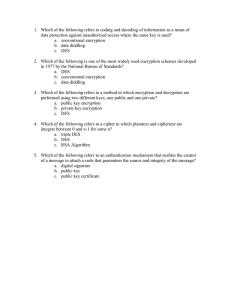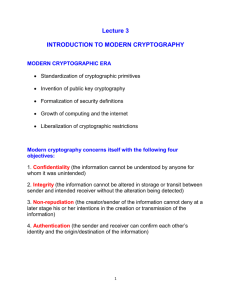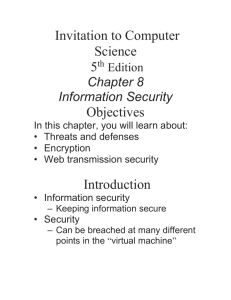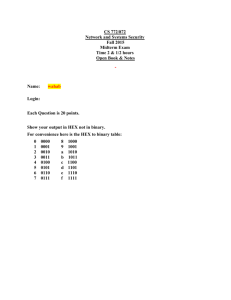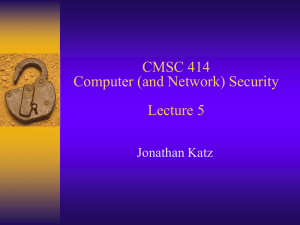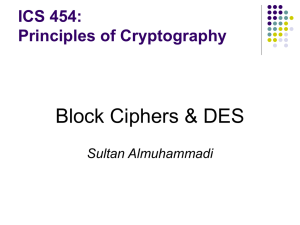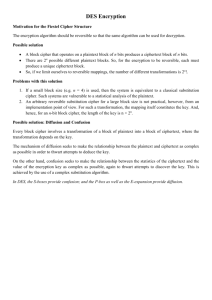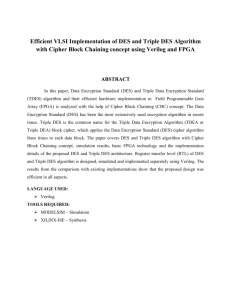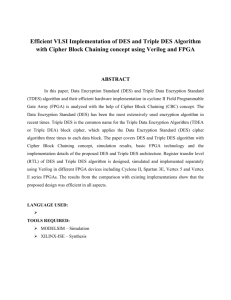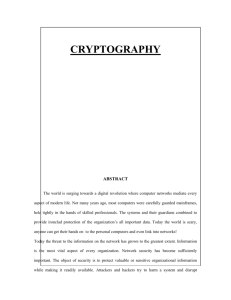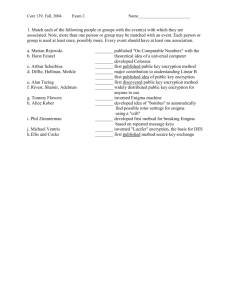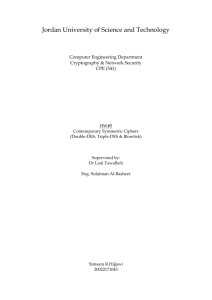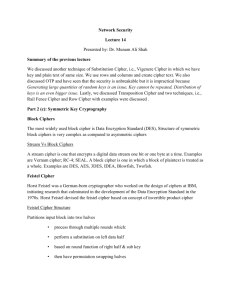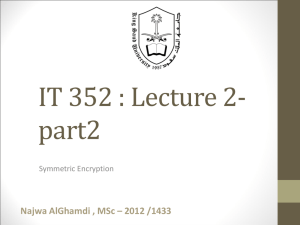CPET 364 * Test 1
advertisement
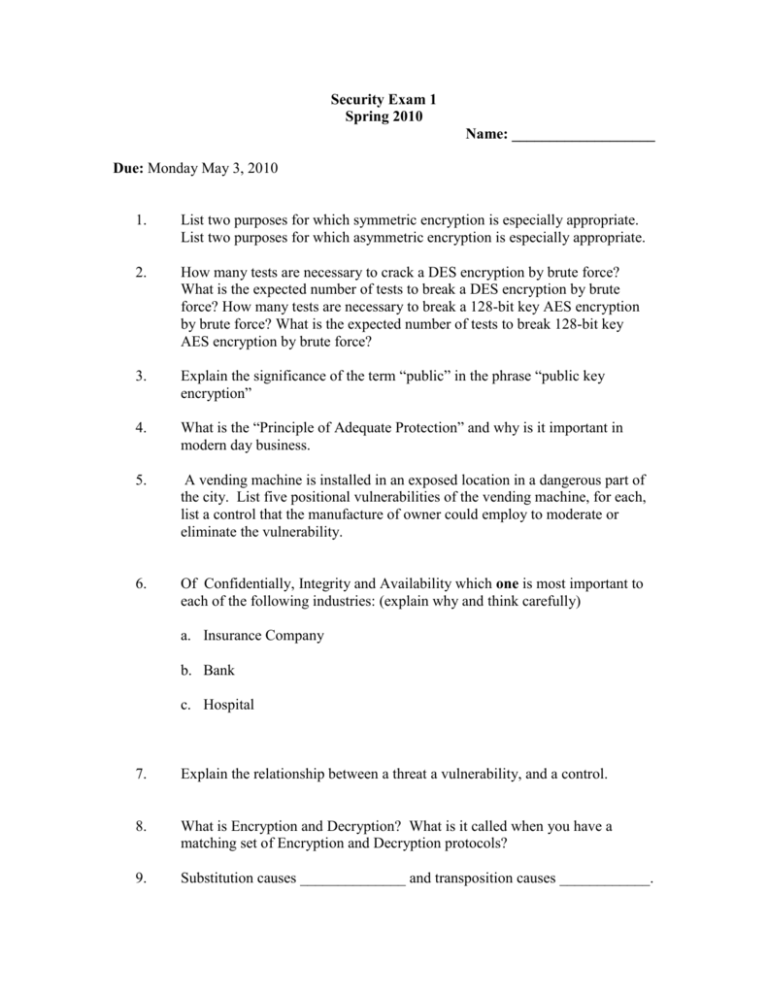
Security Exam 1 Spring 2010 Name: ___________________ Due: Monday May 3, 2010 1. List two purposes for which symmetric encryption is especially appropriate. List two purposes for which asymmetric encryption is especially appropriate. 2. How many tests are necessary to crack a DES encryption by brute force? What is the expected number of tests to break a DES encryption by brute force? How many tests are necessary to break a 128-bit key AES encryption by brute force? What is the expected number of tests to break 128-bit key AES encryption by brute force? 3. Explain the significance of the term “public” in the phrase “public key encryption” 4. What is the “Principle of Adequate Protection” and why is it important in modern day business. 5. A vending machine is installed in an exposed location in a dangerous part of the city. List five positional vulnerabilities of the vending machine, for each, list a control that the manufacture of owner could employ to moderate or eliminate the vulnerability. 6. Of Confidentially, Integrity and Availability which one is most important to each of the following industries: (explain why and think carefully) a. Insurance Company b. Bank c. Hospital 7. Explain the relationship between a threat a vulnerability, and a control. 8. What is Encryption and Decryption? What is it called when you have a matching set of Encryption and Decryption protocols? 9. Substitution causes ______________ and transposition causes ____________. 10. If a password can be 5-12 characters consisting of only lower case letters, upper case letters, and/or fifteen of the special characters, how many possible combinations of passwords are there? (formula only) 11. Explain the notation and function of each of the following: a. C1 E ( K Pr i A , m) b. C 2 E ( K Pub B , m) c. C3 E ( K , m) or C3 E ( K sec ret , m) d. D( K Pri B , D( K Pub A , C1 )) 12. What is trust and what makes up trust? 13. Complete: a. Demonstrate the monoalphabetic cipher C E ( pi ) 10 on: “Have a Good Day”. b. Construct an equation that would decipher the cipher of part a. 14. Is there such a thing as a perfect cipher? If so, what is it? Defend your answer. 15. Perform standard five-columnar transposition on the follow: “This is five columnar transposition” 16. Perform the Vernam Cipher on “Hello” using the random number stream “21 15 18 19 40”. Is there any weakness in this method? 17. What is a certificate and why do we have certificate authorities? 18. What is repudiation and what security method do we use to show it? 19. The use of non-repeating keys, sometimes written on single sheets of paper is known as a __________ _______. 20. On the given protocol, where could a successful attack take place when Bob (b) and Alice (a) communicate? Public Keys 1: Alice Requests Bobs Key 2. Public Key Authority Reponds with Bob's Key Kpub-b 5. C2=E(Ksecret,data) Alice 6. D(Ksecret, C2) Bob 3. C =E(Kpub-b,Ksecret) 4. D(Kpri-B,C) 21. What is a Message Digest (checksum) and why is it used? 22. Answer the following questions about DES: a. What is an S-box and P-box inside of DES? b. What is the key length of DES? c. How many rounds are performed in DES? d. Is this considered a streaming or block cipher? 23. In a ______ _______ attack, the attacker tries all possible passwords. 24. Explain the use of salt in UNIX passwords. Why is it used? 25. Describe a buffer overflow - What type of Internet attack would be performed using a buffer overflow? 26. Describe two possible types of covert channels. 27. Explain the term virus signature. Can a virus remain hidden and not have a signature? Explain your answer. 28. A ciphertext has been generated with an affine cipher (you might need to look up the word). The most frequent letter of the ciphertext is “B”, and the second most frequent letter of the ciphertext is “U”. Break the code. 29. Compute the bits number 1, 16, 33 and 48 at the output of the first round of the DES decryption, assuming that the ciphertext block is composed of all ones and the external key is composed of all ones. (page 733 of text) 30. Match each to the best answer. ___ Rabbit ___ Virus ___ Trojan horse ___ Logic Bomb ___ Worm ___ Malicious Code ___ Time Bomb ___ Trapdoor ___ Salami Attack ___ Polymorphic a. Replicates itself without limit to exhaust resources. b. Allows unauthorized access to functionality. c. Propagates copies of itself through a network d. Attaches itself to a program and propagates itself to other programs. e. Triggers actions when condition occurs. f. Contains unexpected, additional functionality. g. Triggers action when specific time occurs. h. changes appearance. i. seemingly inconsequential data. j. unanticipated or undesired effect in a program.



